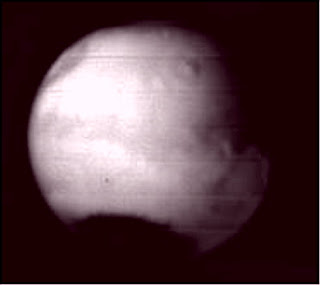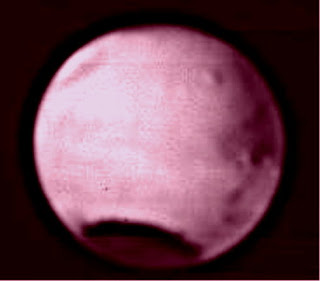 In my last post I moaned, jokingly of course, about a TV film crew hogging my favourite sunset photography spot on Mauna Kea, but didn't know who these people were other than they spoke with British accents and the topic appeared to be about Mars. I speculated that the crew may have been filming for the famous BBC show "The Sky at Night" which I grew up watching and is still going more than 52 years after the first show. The Sky at Night team have been out here on Mauna Kea before so I wouldn't have been surprised to learn they were visiting again, but usually we know about it in advance.
In my last post I moaned, jokingly of course, about a TV film crew hogging my favourite sunset photography spot on Mauna Kea, but didn't know who these people were other than they spoke with British accents and the topic appeared to be about Mars. I speculated that the crew may have been filming for the famous BBC show "The Sky at Night" which I grew up watching and is still going more than 52 years after the first show. The Sky at Night team have been out here on Mauna Kea before so I wouldn't have been surprised to learn they were visiting again, but usually we know about it in advance.Thanks to Chris North's comment on the post though, a researcher for The Sky at Night, I learned this was not a Sky at Night crew but he suggested it might be a BBC crew working with Prof. Brian Cox, a particle physicist and musician who often presents science programmes for the BBC. After a little research and finding Brian's twitter page, I'm 99% certain this was Brian working on a BBC documentary called "Seven Wonders of the Solar System". I am very grateful to Chris for his tip as it led me in the right direction!
From Brian's tweets (twits?) I learned that he was filming a segment on Olympus Mons, a massive volcano on Mars. For those not familiar with the subject, Olympus Mons is the largest known volcano in our Solar System. It dwarfs Mauna Loa which I briefly described in "Sunset views of Mauna Loa", its height above Mars' surface is an incredible 16 miles or three times the height of Everest and is nearly 400 miles wide. Considering Mars is a much smaller planet than the Earth the size of Olympus Mons is simply staggering. The reason Brian was visiting Mauna Kea (and both Kilauea and Mauna Loa) was, I suspect, because Olympus Mons is a shield volcano and therefore the same type as the Hawaiian volcanoes.
Coincidentally, Olympus Mons played a small part in my career a few years ago. I was commissioning a new mid-infrared instrument called Michelle and the team and I thought it might be a nice idea to see if we could image Olympus Mons although we were rather pessimistic about the chances of success. Mid-infrared observing from the ground is really difficult, even on Mauna Kea, but we thought it would be a bit of fun and a break from the more rigorous commissioning schedule. In addition, we were still working with an engineering array rather than a decent scientific-grade array, so we really didn't expect to see much more than the disk of Mars and even then it would be horribly distorted. It turned out we were wrong.
 Mars at 7.9-microns. The dark patch at the bottom is the south pole, the blob just to the right of centre and near the top is Olympus Mons. 7.9-microns is a tough spot to observe through our atmosphere, so we were quite surprised to get this image! The stripes are due to the readout of the poor-quality engineering-grade mid-infrared array.
Mars at 7.9-microns. The dark patch at the bottom is the south pole, the blob just to the right of centre and near the top is Olympus Mons. 7.9-microns is a tough spot to observe through our atmosphere, so we were quite surprised to get this image! The stripes are due to the readout of the poor-quality engineering-grade mid-infrared array. At 11.6-microns the volcano really stood out. I was astonished when I saw this image for the first time. It might not look good to most people, but we really didn't expect to see any features at all yet this thing clearly exhibited a shadow and must be a large mountain. (Three quarters of the way up, just right of centre).
At 11.6-microns the volcano really stood out. I was astonished when I saw this image for the first time. It might not look good to most people, but we really didn't expect to see any features at all yet this thing clearly exhibited a shadow and must be a large mountain. (Three quarters of the way up, just right of centre). This might look like a terrible image, but it's was taken at 20-microns which is just about the toughest wavelength to observe from the ground, you really need to use some special techniques and have really clear and dry conditions. To say I was somewhat pleased when I saw this pop up on our displays would be a bit of an understatement!
This might look like a terrible image, but it's was taken at 20-microns which is just about the toughest wavelength to observe from the ground, you really need to use some special techniques and have really clear and dry conditions. To say I was somewhat pleased when I saw this pop up on our displays would be a bit of an understatement!



6 comments:
Could you explain the micron thing a little more? It sounds like a very, very short wavelength. The length of infrared, I guess, but I really know nothing about that. I'm just curious about the differences in what is revealed in the three photos depending on the wavelength. Like, why does the clearest image seem to be the middle one? And the brightest one the last one?
Wait - you stood 6 feet away from Brian Cox and you didn't get me an autograph? What kind of friend are you?
Punagreek - the kind of friend that had no idea it was Brian Cox! Actually, this is the only occasion I think I wish I was on twitter, I could have sent him an apology for not having a clue who he was and if I realised I would have been very happy to give him a quick tour of the telescope!
I did actually see him at HP but saw no camera crew and assumed he was just another astronomer.
Keera - I'll try answering without giving a physics lecture! Microns are a unit of length and are 1000 times smaller than millimeters. Infrared light has a much longer wavelength than visible light but astronomers typically refer to units that have sensible-sounding numbers for the wavelength they work at. Optical astronomers use Angstroms or nanometers, infrared astronomers use microns. If you're a weird radio or submillimetre astronomer, you use frequencies instead of wavelengths. It's a bit of a mess I'm afraid but we know how to convert between all the units and make sense of them, but the public in general can't do that and I apologise for using unfamiliar units. It's just habit!
7.9 microns is very close to a part of the spectrum where (infrared) light can't get through the atmosphere, so the quality of an image is often affected by the sky. On the other hand, the shorter the wavelength the better detail you can see, so 7.9 will give you better resolution than longer wavelengths.
At 11.6 microns you're right in the middle of a "window" in the atmosphere, i.e., it's not affected very much by water, CO, CO2 etc in the atmosphere above us, to it generally gives the clearest image.
20-microns is very hard to observe at because the atmosphere is very bright at that wavelength. Cold things shine brightly at these wavelengths (such as the atmosphere) and Mars is quite cold, so shines brighter at 20-microns compared to 10-microns. Unfortunately, at the longer wavelength the resolution is lower so although the planet looks brighter, you see much less detail.
I know I've missed a lot out but hope this helps a little. Happy to explain any particular point you're interested in or don't understand.
Tom
Thanks, Tom, for giving me such a nice explanation. The things I learn on this blog! I take it that you take pictures at different wavelengths all the time because of the variation in detail depending on resolution (and that stupid atmosphere always hanging around)?
Keera - this could turn into a lecture series!
The reason you mention is something that is done but is usually not the main reason, there are so many other reasons why you might want to look at something at different wavelengths. I'll try and explain the most common one.
Physics basics: something that is hot shines at short wavelengths (e.g., ultraviolet and optical) while something that is cold shines at longer wavelengths (e.g., infrared and submillimetre -I'd mention radio as a longer wavelength but that opens up a whole new can of worms!).
If you want to get a rough idea if an astronomical object (star or galaxy for instance) is hot, warm or cool is to take images of it at several wavelengths. You can then see at which wavelength it's brightest and from that you can tell its temperature. So, that way you can tell between a brown dwarf (a very small star that it is only just bigger than a large planet and is relatively cool) and a star like our sun. The brown dwarf is brightest in the infrared whereas our sun is brightest in the optical (the wavelength our eyes work at, fortunately enough!).
This is an extremely simplistic explanation, I'm sure you understand, but it is the basis of why we measure an object's brightness at different wavelengths.
Just as a bonus, there are complications! For instance, brown dwarves have several molecular species in their atmospheres (hotter stars put out energy that destroys molecules) and these molecules absorb light in the infrared, so it can complicate the situation (they dim the infrared light we measure and can make the analysis quite complicated). Distant galaxies may be very energetic and hot, but the expansion of the universe shifts their peak wavelengths into the infrared (think doppler shift or the infamous "red shift") making them look like cool objects. Another example involves hot stars or galaxies surrounded by dust. The object gives of ultraviolet light which is absorbed by the dust which in turn re-emits the energy at infrared wavelengths, making the object look much colder than it is (look up "infrared excess" one day in google!).
What astronomers usually do is get a rough idea of what an object is by imaging the object at several wavelengths and then pick the interesting ones. They then look at those objects again using spectroscopy which allows one to really determine what that object actually is since you'll be able to determine what atoms and molecules are there and what state they're in.
Phew! Hope that helps, as always I've left a lot of details out and am happy to answer questions!
Tom
Your answer helped a lot. (I was just very slow in reading it.) I actually understand better what it is you astronomers are doing when you're taking pictures of the stars. And I know a bit more about brown dwarfs.:-) Thanks, Tom!
Post a Comment